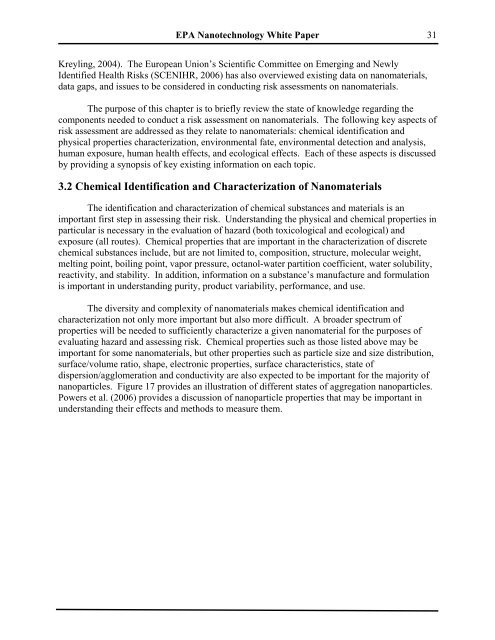Nanotechnology White Paper - US Environmental Protection Agency
Nanotechnology White Paper - US Environmental Protection Agency
Nanotechnology White Paper - US Environmental Protection Agency
Create successful ePaper yourself
Turn your PDF publications into a flip-book with our unique Google optimized e-Paper software.
EPA <strong>Nanotechnology</strong> <strong>White</strong> <strong>Paper</strong><br />
Kreyling, 2004). The European Union’s Scientific Committee on Emerging and Newly<br />
Identified Health Risks (SCENIHR, 2006) has also overviewed existing data on nanomaterials,<br />
data gaps, and issues to be considered in conducting risk assessments on nanomaterials.<br />
The purpose of this chapter is to briefly review the state of knowledge regarding the<br />
components needed to conduct a risk assessment on nanomaterials. The following key aspects of<br />
risk assessment are addressed as they relate to nanomaterials: chemical identification and<br />
physical properties characterization, environmental fate, environmental detection and analysis,<br />
human exposure, human health effects, and ecological effects. Each of these aspects is discussed<br />
by providing a synopsis of key existing information on each topic.<br />
3.2 Chemical Identification and Characterization of Nanomaterials<br />
The identification and characterization of chemical substances and materials is an<br />
important first step in assessing their risk. Understanding the physical and chemical properties in<br />
particular is necessary in the evaluation of hazard (both toxicological and ecological) and<br />
exposure (all routes). Chemical properties that are important in the characterization of discrete<br />
chemical substances include, but are not limited to, composition, structure, molecular weight,<br />
melting point, boiling point, vapor pressure, octanol-water partition coefficient, water solubility,<br />
reactivity, and stability. In addition, information on a substance’s manufacture and formulation<br />
is important in understanding purity, product variability, performance, and use.<br />
The diversity and complexity of nanomaterials makes chemical identification and<br />
characterization not only more important but also more difficult. A broader spectrum of<br />
properties will be needed to sufficiently characterize a given nanomaterial for the purposes of<br />
evaluating hazard and assessing risk. Chemical properties such as those listed above may be<br />
important for some nanomaterials, but other properties such as particle size and size distribution,<br />
surface/volume ratio, shape, electronic properties, surface characteristics, state of<br />
dispersion/agglomeration and conductivity are also expected to be important for the majority of<br />
nanoparticles. Figure 17 provides an illustration of different states of aggregation nanoparticles.<br />
Powers et al. (2006) provides a discussion of nanoparticle properties that may be important in<br />
understanding their effects and methods to measure them.<br />
31

















